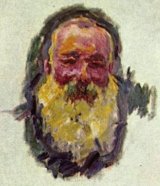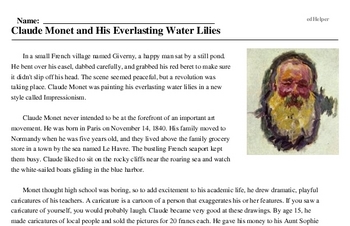Claude Monet and His Everlasting Water Lilies
Claude Monet
Reading Comprehension for November 14
In a small French village named Giverny, a happy man sat by a still pond. He bent over his easel, dabbed carefully, and grabbed his red beret to make sure it didn't slip off his head. The scene seemed peaceful, but a revolution was taking place. Claude Monet was painting his everlasting water lilies in a new style called Impressionism.
Claude Monet never intended to be at the forefront of an important art movement. He was born in Paris on November 14, 1840. His family moved to Normandy when he was five years old, and they lived above the family grocery store in a town by the sea named Le Havre. The bustling French seaport kept them busy. Claude liked to sit on the rocky cliffs near the roaring sea and watch the white-sailed boats gliding in the blue harbor.
Monet thought high school was boring, so to add excitement to his academic life, he drew dramatic, playful caricatures of his teachers. A caricature is a cartoon of a person that exaggerates his or her features. If you saw a caricature of yourself, you would probably laugh. Claude became very good at these drawings. By age 15, he made caricatures of local people and sold the pictures for 20 francs each. He gave his money to his Aunt Sophie so she could keep it safe. She encouraged his art and also let him paint in her attic studio.
Monet's caricature portraits were soon exhibited in the local art supply store. There, he met Eugene Boudin who encouraged him to try something new. His radical idea was for Monet to try painting outdoors. At that time, most artists painted inside, and even when they did landscapes, they brought their sketches back to their dusty studios to finish. Boudin told Monet that paintings done outside had much more strength and power. Maybe that is why Monet enjoyed sitting by the pond and painting water lilies for hours at the close of his life.




